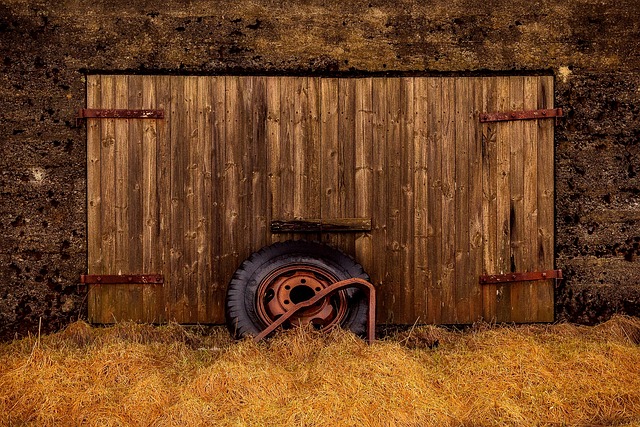In Wagga Wagga, New South Wales, Australia, farm shed designs must be tailored to withstand the region’s harsh and variable climatic conditions, including extreme temperatures, irregular rainfall, and strong winds. Utilizing durable materials like Colorbond steel, which resists corrosion and UV radiation, is key for maintaining structural integrity. These sheds should be strategically placed and equipped with ventilation systems to ensure the comfort and productivity of livestock, as well as protect equipment and crops. Energy efficiency is paramount, with thermal insulation and reflective roofing materials regulating internal temperatures effectively. The integration of renewable energy solutions, such as solar panels, enhances sustainability and operational reliability, especially during power outages. The article underscores the importance of considering local climate conditions and sustainable practices to optimize farm shed performance and longevity in Wagga Wagga. Farmers prioritize resilient materials like galvanized steel and Colorbond™ cladding to safeguard against intense heat, storms, and high humidity, while also ensuring energy efficiency through insulation and reflective roofing. These design choices collectively ensure that farm sheds in Wagga Wagga can endure the local climate, remain economically viable, and contribute to sustainable agricultural practices.
Exploring the robust construction of farm sheds tailored for the challenging climatic conditions of Wagga, this article delves into the essential design considerations and material choices that ensure durability and resilience. Whether bracing against the scorching sun or safeguarding against the region’s unpredictable weather, these structures are engineered to meet the specific needs of the area. Join us as we examine the strategies behind optimizing farm shed designs in Wagga, highlighting the critical factors that contribute to their longevity and performance.
- Optimizing Farm Shed Designs for Resilient Performance in Wagga’s Climate
- Material Selection and Structural Adaptations for Durability in Wagga’s Diverse Weather Patterns
Optimizing Farm Shed Designs for Resilient Performance in Wagga’s Climate

In the regional center of Wagga Wagga, located within the Riverina region of New South Wales, Australia, farm shed designs must be tailored to withstand the unique and often variable climatic conditions. To optimize performance and ensure longevity, farm sheds in this area must be engineered to handle extremes in temperature, erratic rainfall patterns, and high winds characteristic of the Wagga weather. The use of durable materials such as Colorbond steel, known for its robustness against corrosion and UV radiation, is a critical factor in maintaining the integrity of these structures over time. Additionally, strategic placement of sheds to shelter from prevailing winds, coupled with proper ventilation systems, can significantly enhance livestock comfort and productivity while protecting stored equipment and crops.
Furthermore, incorporating energy-efficient design elements, like thermal insulation and reflective roofing, contributes to maintaining a stable internal environment. This is particularly important during the scorching summers and mild winters that define Wagga’s climate. By prioritizing resilient performance through meticulous planning and design, farm sheds in Wagga not only safeguard against environmental stressors but also align with sustainable practices that reduce the carbon footprint associated with agriculture. The integration of renewable energy solutions, such as solar panels on shed roofs, further supports this commitment to sustainability while ensuring that operations can continue uninterrupted even during power outages.
Material Selection and Structural Adaptations for Durability in Wagga’s Diverse Weather Patterns

In Wagga Wagga, a region characterized by its diverse and often extreme weather patterns, selecting appropriate materials for farm sheds is crucial for ensuring longevity and protection of agricultural assets. Local farmers have long recognized the need for robust structures that can withstand everything from scorching summers to frequent storms. Consequently, materials chosen for farm shed construction are not left to chance; they are carefully selected based on their durability, resistance to weather elements, and low maintenance requirements. Galvanized steel and Colorbond™ cladding are favored due to their resilience against the corrosive effects of humidity and salt, which are prevalent in the Wagga region. These materials also reflect the intense solar radiation that can cause other materials to degrade over time. Furthermore, strategic design elements such as high eaves, large roof overhangs, and well-positioned ventilation play a significant role in safeguarding farm equipment and produce from the harsh weather conditions prevalent in Wagga. The integration of these features ensures that the sheds remain functional and secure, maintaining their structural integrity regardless of the weather.
Structural adaptations in farm shed design have evolved to meet the specific challenges posed by the Wagga climate. These adaptations often include reinforced frames to withstand strong winds, a common occurrence during the region’s storm seasons. The sheds are also engineered to allow for adequate drainage and water runoff, mitigating the risk of water damage during heavy rains. Additionally, the inclusion of energy-efficient design elements, such as thermal insulation and reflective roofing, helps in maintaining a stable interior temperature, which is beneficial both for climate control and for reducing energy consumption. These adaptations are essential for ensuring that farm sheds not only endure the region’s weather but also remain cost-effective and sustainable over time. The combination of carefully chosen materials and thoughtfully designed structural features ensures that these agricultural structures can withstand Wagga’s diverse weather patterns, offering a reliable shelter for crops and machinery throughout the year.
In conclusion, the design and construction of farm sheds in the Wagga region must account for its distinct climatic challenges. By optimizing farm shed designs and carefully selecting materials that withstand the area’s varied weather patterns, these structures become not just shelters but vital assets for agricultural productivity. The adaptations highlighted in this article underscore the importance of resilient farming infrastructure, ensuring that farm sheds serve their purpose effectively amidst the dynamic conditions typical of Wagga. Farmers in the region can confidently rely on these robust constructions to protect their investments and maintain operational efficiency throughout the seasons.
